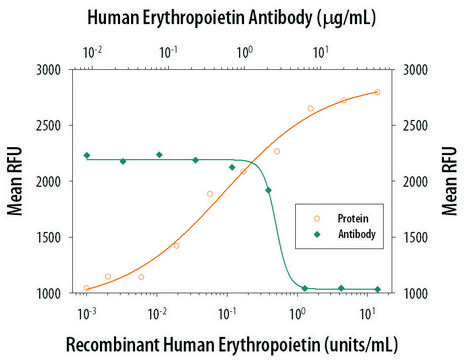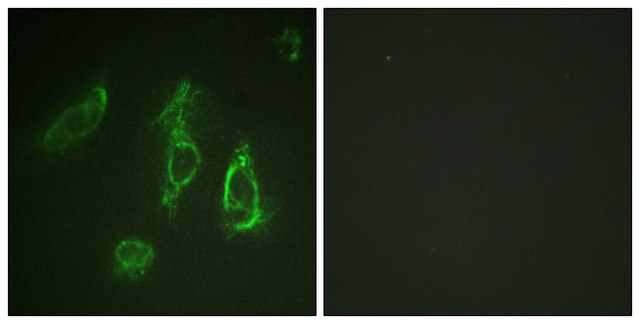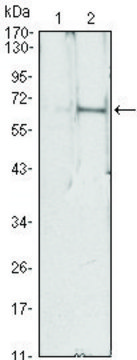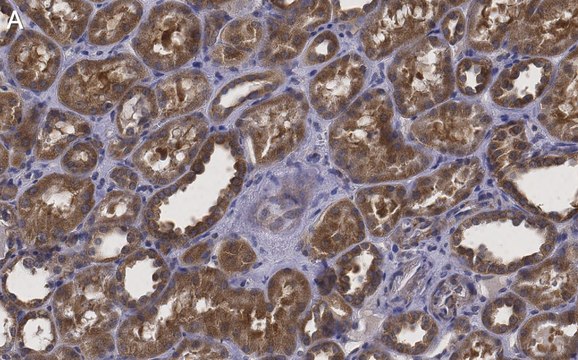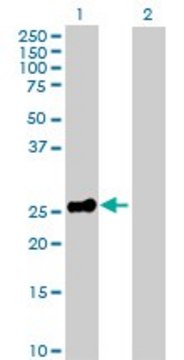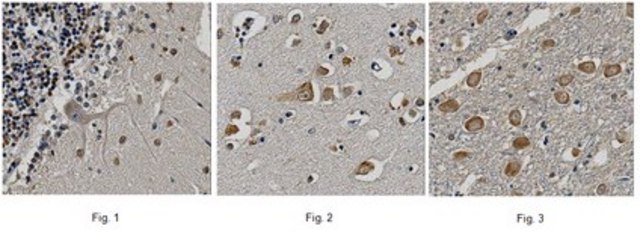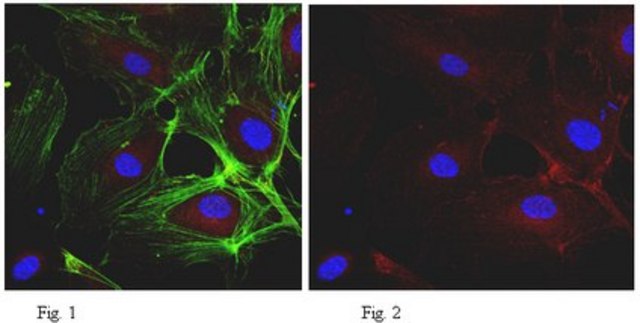MABS1286
Anti-EPO-R Antibody, clone BCO-3H2
clone BCO-3H2, from rat
Sign Into View Organizational & Contract Pricing
All Photos(1)
Synonym(s):
Erythropoietin receptor
UNSPSC Code:
12352203
eCl@ss:
32160702
NACRES:
NA.41
Recommended Products
biological source
rat
Quality Level
antibody form
purified immunoglobulin
antibody product type
primary antibodies
clone
BCO-3H2, monoclonal
species reactivity
human
packaging
antibody small pack of 25 μg
technique(s)
immunofluorescence: suitable
immunohistochemistry: suitable
immunoprecipitation (IP): suitable
western blot: suitable
isotype
IgG2bκ
NCBI accession no.
UniProt accession no.
shipped in
ambient
target post-translational modification
unmodified
Gene Information
human ... EPOR(2057)
Related Categories
General description
Erythropoietin receptor (UniProt: P19235; also known as EPO-R) is encoded by the EPOR gene (Gene ID: 2057) in human. EPO-R is a single-pass type 1 membrane protein that mediates erythropoietin-induced erythroblast proliferation and differentiation. It is synthesized with a signal peptide (aa 1-24) that is cleaved to produce the mature form. Upon EPO stimulation, EPO-R homodimerizes and gets phosphorylated on C-terminal tyrosine residues by JAK2. The phosphotyrosine motifs are also recruitment sites for several SH2-containing proteins and adapter proteins which mediate cell proliferation. The tyrosine-phosphorylated form interacts with several SH2 domain-containing proteins. The EPO-R is expressed in erythroid cells and erythroid progenitor cells. Three isoforms of EPO-R has been described that are produced by alternate splicing. Isoform EPOR-F is the most abundant form in EPO-dependent erythroleukemia cells and in late-stage erythroid progenitors. Isoform EPOR-S and isoform EPOR-T are the predominant forms in bone marrow. Isoform EPOR-T is the most abundant from in early-stage erythroid progenitor cells. Mutation in EPOR gene are linked to familial erythrocytosis that is characterized by elevated serum red blood cell mass, hemoglobin and hematocrit, and increased sensitivity of erythroid progenitors to erythropoietin.
Specificity
Clone BCO-3H2 is a rat monoclonal antibody that detects erythopoietin receptor in human cells. It targets an epitope with in 17 amino acids from the C-terminal region.
Immunogen
Epitope: cytoplasmic domain
KLH-conjugated linear peptide corresponding to 17 amino acids from the human erythropoietin receptor.
Application
Anti-EPO-R, clone BCO-3H2, Cat. No. MABS1286, is a rat monoclonal antibody that detects erythropoietin receptor and has been tested for use in Immunofluorescence, Immunohistochemistry, Immunoprecipitation, and Western Blotting.
Immunohistochemistry Analysis: A representative lot detected EPO-R in Immunohistochemistry applications (Maxwell, P., et. al. (2015). Br J Haematol. 168(3):429-42).
Immunoprecipitation Analysis: A representative lot detected EPO-R in Immunoprecipitation applications (Maxwell, P., et. al. (2015). Br J Haematol. 168(3):429-42).
Immunofluorescence Analysis: A representative lot detected EPO-R in Immunofluorescence applications (Maxwell, P., et. al. (2015). Br J Haematol. 168(3):429-42).
Western Blotting Analysis: A representative lot detected EPO-R in Western Blotting applications (Maxwell, P., et. al. (2015). Br J Haematol. 168(3):429-42).
Immunoprecipitation Analysis: A representative lot detected EPO-R in Immunoprecipitation applications (Maxwell, P., et. al. (2015). Br J Haematol. 168(3):429-42).
Immunofluorescence Analysis: A representative lot detected EPO-R in Immunofluorescence applications (Maxwell, P., et. al. (2015). Br J Haematol. 168(3):429-42).
Western Blotting Analysis: A representative lot detected EPO-R in Western Blotting applications (Maxwell, P., et. al. (2015). Br J Haematol. 168(3):429-42).
Research Category
Signaling
Signaling
Quality
Evaluated by Western Blotting in UT-7 cell lysates.
Western Blotting Analysis: 0.5 µg/mL of this antibody detected EPO-R in 10 µg of UT-7 cell lysates.
Western Blotting Analysis: 0.5 µg/mL of this antibody detected EPO-R in 10 µg of UT-7 cell lysates.
Target description
~58 kDa observed; 55.07 kDa calculated. Uncharacterized bands may be observed in some lysate(s).
Physical form
Format: Purified
Protein G purified
Purified rat monoclonal antibody IgG2b in PBS without azide.
Storage and Stability
Stable for 1 year at -20°C from date of receipt.
Handling Recommendations: Upon receipt and prior to removing the cap, centrifuge the vial and gently mix the solution. Aliquot into microcentrifuge tubes and store at -20°C. Avoid repeated freeze/thaw cycles, which may damage IgG and affect product performance.
Handling Recommendations: Upon receipt and prior to removing the cap, centrifuge the vial and gently mix the solution. Aliquot into microcentrifuge tubes and store at -20°C. Avoid repeated freeze/thaw cycles, which may damage IgG and affect product performance.
Other Notes
Concentration: Please refer to lot specific datasheet.
Disclaimer
Unless otherwise stated in our catalog or other company documentation accompanying the product(s), our products are intended for research use only and are not to be used for any other purpose, which includes but is not limited to, unauthorized commercial uses, in vitro diagnostic uses, ex vivo or in vivo therapeutic uses or any type of consumption or application to humans or animals.
WGK
WGK 2
Regulatory Information
新产品
Certificates of Analysis (COA)
Search for Certificates of Analysis (COA) by entering the products Lot/Batch Number. Lot and Batch Numbers can be found on a product’s label following the words ‘Lot’ or ‘Batch’.
Already Own This Product?
Find documentation for the products that you have recently purchased in the Document Library.
Our team of scientists has experience in all areas of research including Life Science, Material Science, Chemical Synthesis, Chromatography, Analytical and many others.
Contact Technical Service
